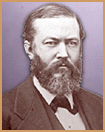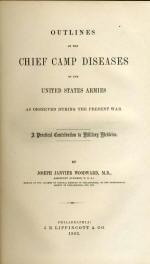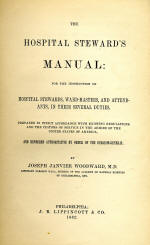 WOODWARD, Joseph Janvier Woodward, surgeon, born in
Philadelphia, Pennsylvania, 30 October, 1833; died near that city, 17
August, 1884. He was graduated at the Philadelphia central high-school in
1850, and at the medical department of the University of Pennsylvania in
1853. He practiced his profession in Philadelphia, and also gave private
instruction in the use of the microscope and in pathological histology, and
with Dr. Charles Bishop he conducted a ' quiz" class in connection with the
course of instruction in the University of Pennsylvania. Subsequently he
became demonstrator in operative surgery in that place and clinical surgical
assistant, and then took charge of the surgical clinic of the university.
WOODWARD, Joseph Janvier Woodward, surgeon, born in
Philadelphia, Pennsylvania, 30 October, 1833; died near that city, 17
August, 1884. He was graduated at the Philadelphia central high-school in
1850, and at the medical department of the University of Pennsylvania in
1853. He practiced his profession in Philadelphia, and also gave private
instruction in the use of the microscope and in pathological histology, and
with Dr. Charles Bishop he conducted a ' quiz" class in connection with the
course of instruction in the University of Pennsylvania. Subsequently he
became demonstrator in operative surgery in that place and clinical surgical
assistant, and then took charge of the surgical clinic of the university.
At
the beginning of the Civil War he entered the United States army as
assistant surgeon, serving with the 2d United States artillery in the Army
of the Potomac, and then became chief medical officer of the 5th division in
the Department of Northeast Virginia, being present at the first battle of
Bull Run. Later he became medical officer of three light batteries in
General Philip Kearny's division in the Army of the Potomac. In May, 1862,
he was assigned to duty in the surgeon-general's office in Washington, and
charged with the duty of collecting materials for a
medical and surgical
history of the war and for a military medical museum. At the close of the
war he received the brevets of captain, major, and lieutenant-colonel, and
on 28 July, 1866, he was commissioned captain and assistant surgeon. He was
made surgeon with the rank of major on 26 June, 1876.
Dr. Woodward was
associated in the management of President Lincoln's case after he was shot,
and the confinement, anxiety, and labor to which he was subjected during the
president's long illness proved too great for him and hastened the "sickness
that terminated his life.
Surgeon
J.J. Woodward
| Place |
Association |
Role |
Description |
Begin Date |
End Date |
|
Patent Office Hospital- HOSPITAL
|
United States
Army |
doctor
|
Recorded the
case of Private Clarence R. Smith.
|
November 1,
1860 (War Boundary) |
December 31,
1865 (War Boundary) |
|
Patent Office Hospital- HOSPITAL
|
United States
Army |
doctor
|
Reported on
Private W.H. Miller's case
|
September 23,
1862 (Unknown) |
Unknown or not
currently known |
He was president of the American
medical association. He published about 100 single papers, and in book-form
"Outlines of the Chief Camp Diseases of the United States Armies"
(Philadelphia, 1863) and contributed to "The Medical and Surgical History of
the War of the Rebellion" (2 vols., Washington, 1870-'9).
John Wilkes Booth died at about sunrise on
Wednesday, April 26, 1865, on the porch of Richard Garrett's house
near Port Royal, Virginia.
Surgeon General
Joseph K. Barnes and Dr. Joseph Janvier Woodward performed John
Wilkes Booth's autopsy aboard the Montauk.
Dr. Woodward
wrote the following detailed account of the autopsy of John Wilkes
Booth: Case JWB: Was killed April 26, 1865, by a conoidal pistol
ball, fired at the distance of a few yards, from a cavalry revolver.
The missile perforated the base of the right lamina of the 4th
lumbar vertebra, fracturing it longitudinally and separating it by a
fissure from the spinous process, at the same time fracturing the
5th vertebra through its pedicle, and involving that transverse
process. The projectile then transversed the spinal canal almost
horizontally but with a slight inclination downward and backward,
perforating the cord which was found much torn and discolored with
blood (see Specimen 4087 Sect. I AMM). The ball then shattered the
bases of the left 4th and 5th laminae, driving bony fragments among
the muscles, and made its exit at the left side of the neck, nearly
opposite the point of entrance. It avoided the 2nd and 3rd cervical
nerves. These facts were determined at autopsy which was made on
April 28. Immediately after the reception of the injury, there was
very general paralysis. The phrenic nerves performed their function,
but the respiration was diaphragmatic, of course, labored and slow.
Deglutition was impracticable, and one or two attempts at
articulation were unintelligible. Death, from asphyxia, took place
about two hours after the reception of the injury.
_________________
Surgical Pathology in the Era of the Civil War: The Remarkable Life
and Accomplishments of Joseph Janvier Woodward, MD
Amy V.
Rapkiewicz, MD; Alan Hawk, BA; Adrienne Noe, PhD; David M. Berman,
MD, PhD
James Janvier Woodward
(1833–1884) was born in Philadelphia, Pa, where he remained for
medical school at the University of Pennsylvania (1853).
He
was the published author of several papers related to microscopic
studies and a founding member of the Pathological Society of
Philadelphia in 1857. Following the outbreak of the Civil War,
Woodward volunteered for the US Army. Initially, he served as an
assistant surgeon and brevet major, participating in several
battles, including the first Battle at Bull Run. In June 1862,
Woodward was assigned to the Office of the Surgeon General to
prepare the medical section of the Medical and Surgical History of
the War of the Rebellion (MSHWR). His duties included acquiring
gross pathologic specimens to document medical conditions suffered
by American soldiers along with the case history. Two years later,
he was given control of the Medical and Microscopical Sections of
the Army Medical Museum (currently the Armed Forces Institute of
Pathology) and the Office of the Surgeon General Records and Pension
Division, where he remained for the rest of his career.
In addition to collecting specimens for the museum's archive, he
coauthored the definitive medical history of the Civil War in the
6-volume 1870 publication of the MSHWR. Woodward's technique using
aniline dyes for staining thin sections of tissue, along with his
pioneering work in photomicroscopy, helped prepare the groundwork
for modern surgical pathology.


 WOODWARD, Joseph Janvier Woodward, surgeon, born in
Philadelphia, Pennsylvania, 30 October, 1833; died near that city, 17
August, 1884. He was graduated at the Philadelphia central high-school in
1850, and at the medical department of the University of Pennsylvania in
1853. He practiced his profession in Philadelphia, and also gave private
instruction in the use of the microscope and in pathological histology, and
with Dr. Charles Bishop he conducted a ' quiz" class in connection with the
course of instruction in the University of Pennsylvania. Subsequently he
became demonstrator in operative surgery in that place and clinical surgical
assistant, and then took charge of the surgical clinic of the university.
WOODWARD, Joseph Janvier Woodward, surgeon, born in
Philadelphia, Pennsylvania, 30 October, 1833; died near that city, 17
August, 1884. He was graduated at the Philadelphia central high-school in
1850, and at the medical department of the University of Pennsylvania in
1853. He practiced his profession in Philadelphia, and also gave private
instruction in the use of the microscope and in pathological histology, and
with Dr. Charles Bishop he conducted a ' quiz" class in connection with the
course of instruction in the University of Pennsylvania. Subsequently he
became demonstrator in operative surgery in that place and clinical surgical
assistant, and then took charge of the surgical clinic of the university.